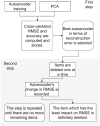Artificial Neural Networks for Short-Form Development of Psychometric Tests: A Study on Synthetic Populations Using Autoencoders
- PMID: 38250505
- PMCID: PMC10795568
- DOI: 10.1177/00131644231164363
Artificial Neural Networks for Short-Form Development of Psychometric Tests: A Study on Synthetic Populations Using Autoencoders
Abstract
Short-form development is an important topic in psychometric research, which requires researchers to face methodological choices at different steps. The statistical techniques traditionally used for shortening tests, which belong to the so-called exploratory model, make assumptions not always verified in psychological data. This article proposes a machine learning-based autonomous procedure for short-form development that combines explanatory and predictive techniques in an integrative approach. The study investigates the item-selection performance of two autoencoders: a particular type of artificial neural network that is comparable to principal component analysis. The procedure is tested on artificial data simulated from a factor-based population and is compared with existent computational approaches to develop short forms. Autoencoders require mild assumptions on data characteristics and provide a method to predict long-form items' responses from the short form. Indeed, results show that they can help the researcher to develop a short form by automatically selecting a subset of items that better reconstruct the original item's responses and that preserve the internal structure of the long-form.
Keywords: autoencoders; machine learning; principal component analysis; short form.
© The Author(s) 2023.
Conflict of interest statement
The authors declared no potential conflicts of interest with respect to the research, authorship, and/or publication of this article.
Figures














References
-
- Alkhayrat M., Aljnidi M., Aljoumaa K. (2020). A comparative dimensionality reduction study in telecom customer segmentation using deep learning and PCA. Journal of Big Data, 7(1), 1–23.
-
- Baldi P., Hornik K. (1989). Neural networks and principal component analysis: Learning from examples without local minima. Neural Networks, 2(1), 53–58.
-
- Bauer D. J. (2005). The role of nonlinear factor-to-indicator relationships in tests of measurement equivalence. Psychological Methods, 10(3), 305–316. - PubMed
-
- Belzak W. C., Bauer D. J. (2019). Interaction effects may actually be nonlinear effects in disguise: A review of the problem and potential solutions. Addictive Behaviors, 94, 99–108. - PubMed
LinkOut - more resources
Full Text Sources
